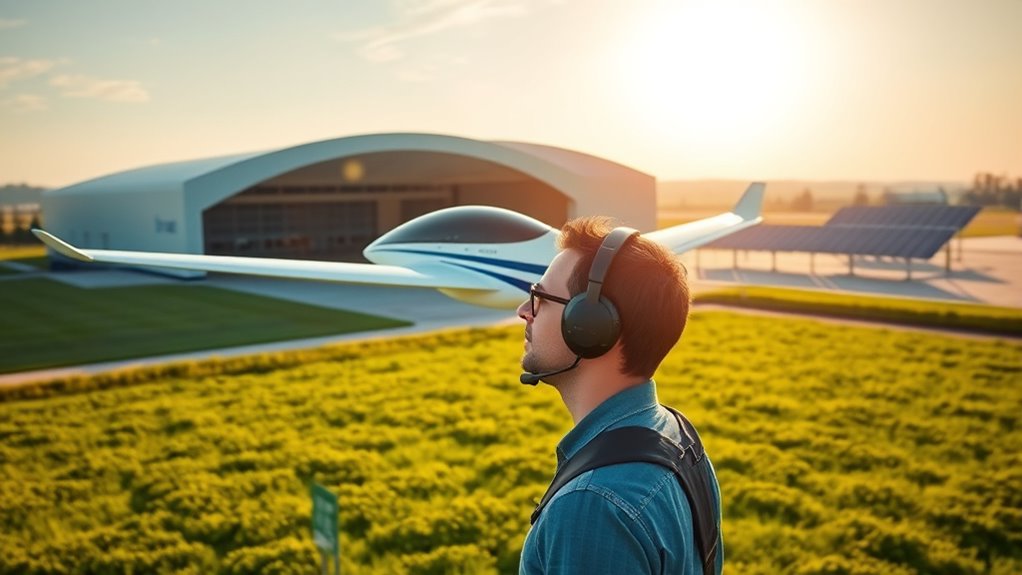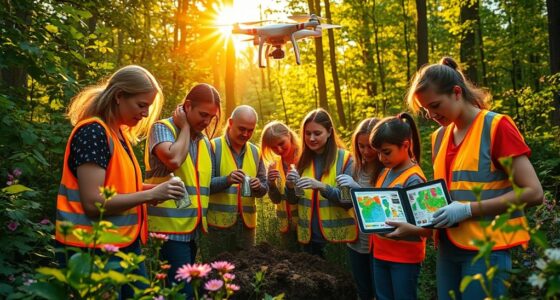Yes, short-haul flights are definitely going green thanks to advances in electric aviation tech. Electric aircraft produce zero emissions during flight, making them cleaner and more eco-friendly. Improved battery technology allows for longer flights, while fast-charging infrastructure at airports reduces turnaround times. Plus, quieter operation benefits nearby communities. As innovations continue, electric short flights are becoming more practical and widespread. Stay with us to discover how these technological and infrastructure changes are shaping a sustainable future for flying.
Key Takeaways
- Electric aircraft produce zero emissions during flight, significantly reducing environmental impact for short-haul routes.
- Advances in battery tech enable longer, more efficient electric flights, making short routes more sustainable.
- Airport infrastructure upgrades, like fast-charging stations, support quick turnaround and eco-friendly operations.
- Quieter electric planes decrease noise pollution around airports, benefiting local communities.
- Ongoing innovations are making electric short-haul flights more practical, cost-effective, and eco-friendly.

Have you ever wondered what the future of flight looks like? With the rapid advancements in electric aviation, short-haul flights could soon become more sustainable than ever before. A key factor driving this shift is the ongoing improvement in battery technology. Today’s batteries are more energy-dense, lighter, and faster to recharge than those from just a few years ago. This progress means electric aircraft can carry enough power to operate short routes efficiently, making electric short-haul flights a viable alternative to traditional fossil-fuel-powered planes. As battery technology continues to evolve, you’ll likely see aircraft that are not only more capable but also more affordable to operate, reducing costs for airlines and travelers alike.
However, the success of electric aviation depends heavily on infrastructure development. Airports will need to adapt quickly, installing specialized charging stations that can handle the energy demands of electric aircraft. Fast-charging capabilities are critical so that planes can quickly recharge during layovers, minimizing downtime and keeping schedules tight. This infrastructure development isn’t just about plugging in planes; it involves creating a holistic ecosystem that supports the entire electric flight process. From upgraded hangars to specialized maintenance facilities, every aspect must evolve to accommodate these new aircraft. You might find that airports become more like high-tech hubs, with dedicated zones for charging and maintenance, making the changeover smoother for airlines and passengers.
The combination of improved battery technology and robust infrastructure development is transforming the landscape of short-haul travel. You could soon hop onto an electric plane that’s quieter, cleaner, and more efficient, all while enjoying the same convenience you’ve come to expect. This shift isn’t just about reducing emissions; it’s also about creating a more resilient and sustainable aviation industry. Electric aircraft produce zero emissions during flight, which means cleaner air and less noise pollution around airports. For travelers, this could translate into a more pleasant experience, with less noise and a smaller carbon footprint. Advancements in battery technology are crucial for achieving this transformative change. Moreover, ongoing research in battery energy density is accelerating the development of longer-range and more powerful batteries, further expanding the potential of electric aircraft. Additionally, the evolving infrastructure development ensures that these innovative aircraft can operate efficiently and sustainably.
In essence, the future of short-haul flying looks promising thanks to these technological and infrastructural advancements. As battery technology becomes more sophisticated and airports upgrade their facilities, you’ll find electric flights becoming a common sight in the skies. This shift not only helps combat climate change but also paves the way for a more innovative, efficient, and sustainable way to travel short distances. Electric aviation is no longer a distant dream; it’s rapidly becoming a practical, eco-friendly reality. Nutritional advantages of green juice are important to consider as part of a healthy lifestyle, which is increasingly relevant in discussions about sustainable living and personal wellness.
Frequently Asked Questions
What Are the Current Limitations of Electric Aircraft Batteries?
You should know that electric aircraft batteries face limitations like battery energy density, which restricts how much power they can store compared to traditional fuels. Charging infrastructure is another hurdle, as it’s not yet widespread or fast enough to support frequent flights. These issues mean batteries need to become more efficient and charging stations more accessible before electric aircraft can fully replace conventional short-haul planes.
How Will Electric Aviation Impact Airport Infrastructure Requirements?
Who knew that electric aviation would turn airports into charging stations? As electric planes take off, you’ll need more charging stations and terminal upgrades to handle the new energy demands. It’s ironic that greener flights require such infrastructure overhauls, but this shift promises faster turnaround times and reduced emissions. So, get ready to see airports transforming into hubs of electricity, not just passengers, making travel greener and more efficient.
Are There Safety Concerns Unique to Electric Planes?
You might wonder if electric planes pose unique safety concerns. Battery safety is a key issue, as batteries can overheat or catch fire if damaged or improperly managed. Emergency procedures must adapt to handle potential battery fires and electrical failures effectively. Ensuring thorough training and advanced safety protocols will be essential. While electric planes offer many benefits, addressing these safety concerns will be critical for widespread adoption and passenger confidence.
What Is the Cost Comparison Between Electric and Traditional Aircraft?
When comparing costs between electric and traditional aircraft, you benefit from lower fuel and maintenance expenses with electric planes. Government incentives can also reduce initial investment costs, making electric aircraft more affordable. Additionally, advances in battery recycling help address environmental concerns and long-term costs. Overall, although electric planes may have higher upfront costs, the savings in operational costs and incentives make them an increasingly economical choice.
How Soon Can We Expect Widespread Adoption of Electric Short-Haul Flights?
They say patience is a virtue, and in electric aviation, it’s no different. Widespread adoption of electric short-haul flights depends on advancements in battery longevity and the development of robust charging infrastructure. You can expect significant progress within the next decade, as technology improves and demand grows. While it might take time, the future of greener, more efficient travel is on the horizon, just waiting for us to seize it.
Conclusion
While electric aviation promises cleaner skies and quieter flights, it’s not a complete solution yet. Just as batteries improve, so must infrastructure and regulations. You might think short-haul flights are doomed to stay dirty, but they’re also the perfect testing ground for greener tech. It’s a paradox: progress depends on change, yet change often feels slow. Embrace the potential, knowing that today’s small steps could lead to tomorrow’s big leap in sustainable travel.










